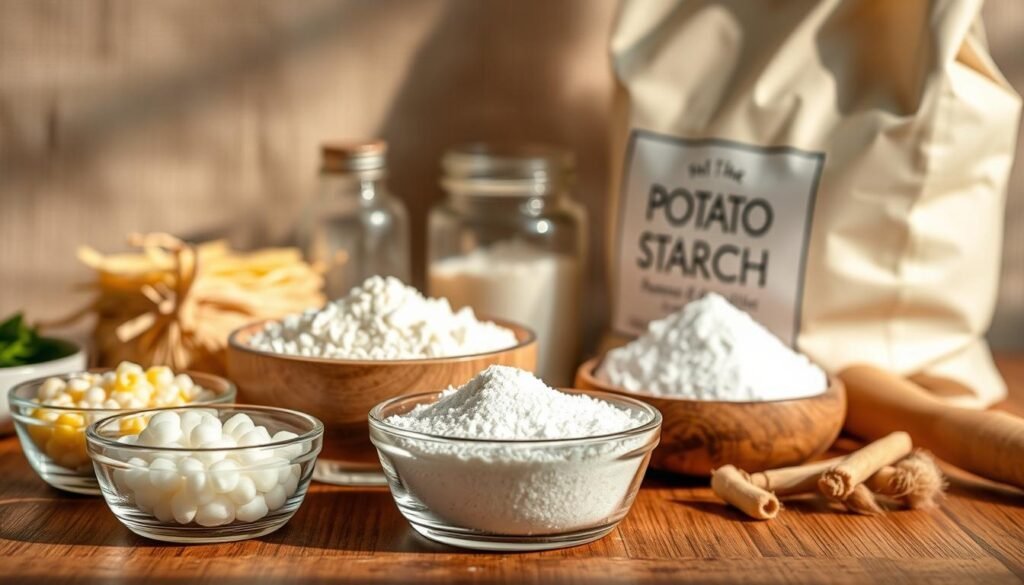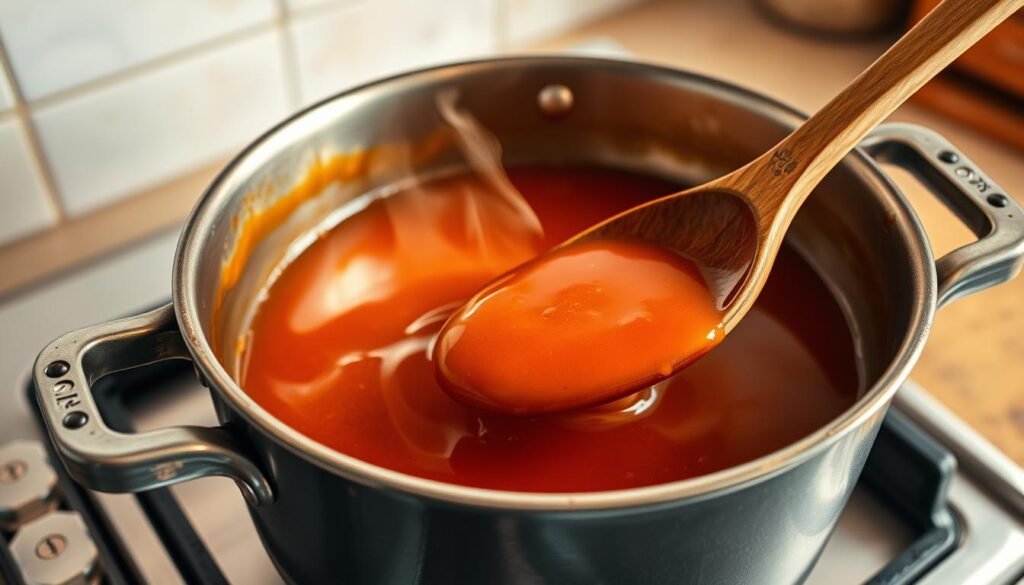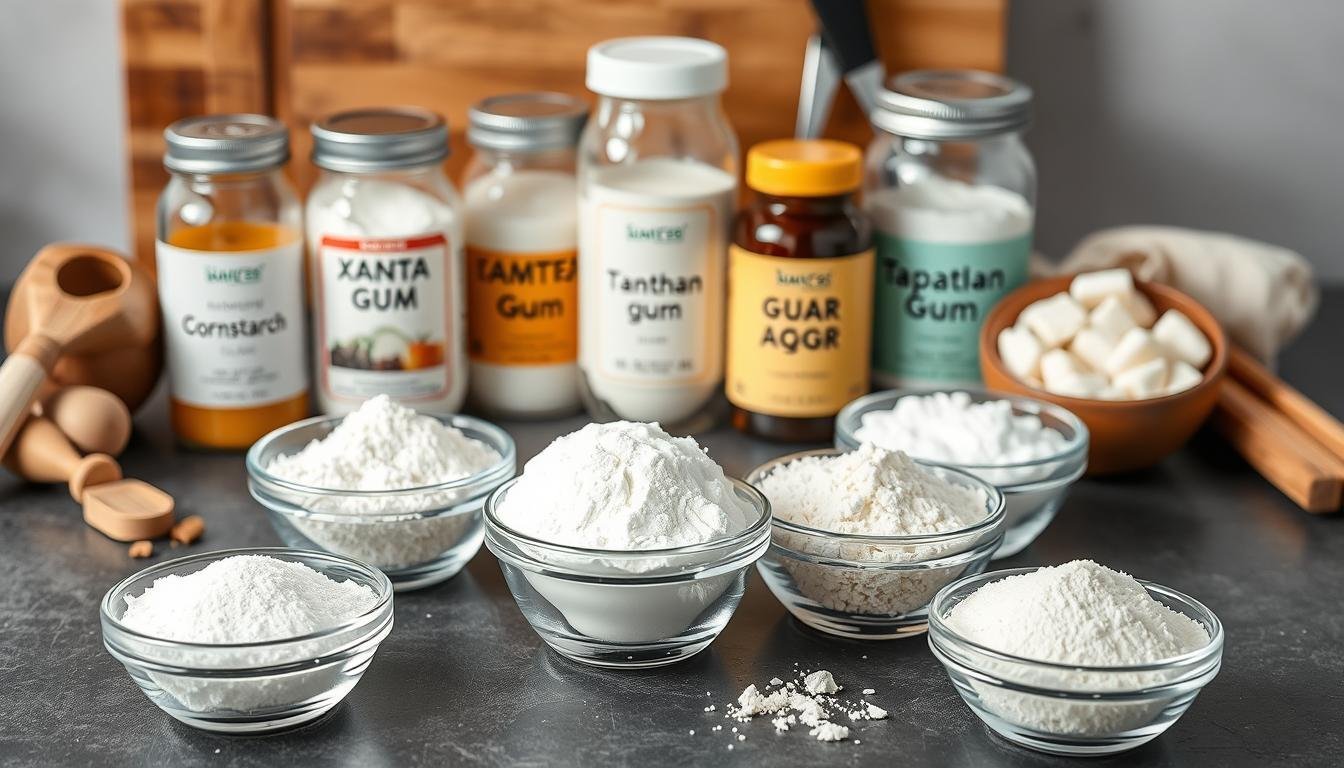Disclosure: This Post Contains Affiliate Links; We earn a commission on purchases.
Getting the right consistency is key in cooking. It makes food taste better. Thickening agents for sauces help turn thin sauces and soups into creamy ones.
Whether you’re new to cooking or have been doing it for years, knowing how to make soup thicker is important. There are many ways to get the right thickness. You can use starches, make a roux, or reduce the liquid.
Key Takeaways
- Thickening agents enhance the texture of sauces and soups.
- Starches, roux, and reduction are common methods for thickening.
- Understanding the right technique is key for the right consistency.
- Thickening agents can make food taste better.
- There are many ways to thicken depending on the dish.
Understanding the Science Behind Thickening
To get the perfect sauce or soup, knowing how thickening works is key. Thickeners change the liquid’s feel by soaking up liquid or making a gel-like texture.
How Thickeners Work
Thickeners like starches soak up liquid and get bigger. This makes the sauce or soup thicker. Flour, cornstarch, and tapioca are common starch thickeners.
The Importance of Temperature
Temperature is very important for thickening. Most thickeners work better when they’re hot. But, too much heat can make them break down and ruin the texture.
Viscosity and Mouthfeel
Viscosity is how thick or runny a liquid is. Getting the right viscosity is important for the mouthfeel. Texture and consistency are key to a good dining experience. Here are some important points:
- Viscosity changes how rich a dish feels.
- Different thickeners change the mouthfeel.
- Temperature changes the viscosity of thickened liquids.
There are many sauce thickening techniques like using roux, slurry, or reduction. Each method works best for different dishes. Knowing these techniques helps get the right consistency and flavor.
Common Starch-Based Thickening Agents
Starch-based thickening agents are key in many kitchens. They come from plants and help sauces and soups reach the right consistency.
Flour: The Traditional Thickener
Flour is a top choice for thickening, mainly in European cooking. It’s used in two main ways: as a slurry or as beurre manié.
Slurry Method
Mix flour with a liquid like water or broth to make a smooth paste. Then add it to your dish. This method avoids lumps.
Beurre Manié Technique
Beurre manié mixes flour and butter. When added to a dish, it melts, thickening the liquid with the flour.
Cornstarch: For Clear, Glossy Sauces
Cornstarch is great for clear, shiny sauces. It doesn’t cloud the liquid, making it perfect for sauces where looks matter.
Other Starches: Arrowroot, Tapioca, and Potato
Arrowroot, tapioca, and potato starch are other options. Arrowroot has a neutral taste and is often used in desserts. Tapioca starch comes from cassava and is gluten-free. Potato starch is also gluten-free and adds a light texture to dishes.

How do I thicken sauces or soups with Roux?
Roux is a key ingredient in many dishes. It’s a mix of flour and fat cooked together. It thickens sauces, soups, and gravies.
Making a Perfect Roux
To make a perfect roux, mix flour and fat well. A good roux should be smooth and free of lumps. Stir it constantly over medium heat.
White, Blond, and Brown Roux
The roux’s color changes with cooking time. This changes its flavor and thickening power.
- White roux is cooked for a short time, making it ideal for cream-based soups.
- Blond roux is cooked a bit longer, giving it a slightly nutty flavor suitable for savory sauces.
- Brown roux is cooked until it reaches a dark color, perfect for rich, intense gravies.
Incorporating Roux Into Your Dish
Once the roux is ready, you can add it to different dishes. How you add it depends on the dish.
For Cream-Based Soups
For cream-based soups, whisk the roux into hot liquid. This makes the soup smooth and creamy.
For Gravies and Savory Sauces
For gravies and savory sauces, add the roux to pan drippings or stock. Then simmer until it’s the right consistency.
Learning to make and use roux can improve your sauces and soups. It takes your cooking to the next level.
Reduction Methods for Intensified Flavors
The art of reduction is a cooking technique. It makes flavors stronger and thickens liquids without extra thickeners. This method cooks down a liquid to boost its taste and make it thicker.
Simmering Techniques
To reduce a sauce or soup well, the right simmering method is key. Maintaining a gentle simmer helps reduce it slowly. This avoids boiling over or burning the pan bottom.
This method needs patience. It can take a few minutes to hours, based on the desired thickness.

When to Choose Reduction Over Thickeners
Reduction is great for making natural flavors stronger without extra thickeners. It’s perfect for soups and sauces where flavor is most important.
Tips for Preventing Over-Reduction
To prevent over-reducing, watch the cooking closely. Check the consistency and taste often. Stop cooking when it’s just right.
This careful watching helps get the right flavor and texture. It gives you soup thickening tips for any cooking.
Protein-Based Thickening Techniques
Protein-based ingredients are great for thickening food. They make dishes more textured and flavorful.
Egg Yolks and Liaison
Egg yolks are a classic thickener, often used in liaison. Learning about thickening agents helps use egg yolks well.
Tempering to Prevent Curdling
Tempering egg yolks is key to avoid curdling. Slowly add hot liquid to egg yolks while whisking. This makes a smooth mix.
Gelatin and Collagen
Gelatin and collagen are great for thickening, good for desserts and some savory dishes. They come from animals and add unique texture.
Dairy Products as Thickeners
Dairy like heavy cream, crème fraîche, yogurt, and sour cream thicken well. They add richness and tangy taste to sauces and soups.
Heavy Cream and Crème Fraîche
Heavy cream and crème fraîche are rich in fat. They make dishes creamy. Reducing them makes flavor and thickness better.
Yogurt and Sour Cream
Yogurt and sour cream are tangy and good for soups and sauces. They add a special flavor.
Using protein-based techniques, cooks can get the right texture and taste. This is true for gravies and soups alike.
Troubleshooting Common Thickening Problems
Getting the right consistency is key. Knowing how to fix common thickening issues can make your cooking better. You might face lumpy sauces, broken emulsions, or the wrong consistency. But, there are ways to solve these problems.
Fixing Lumpy Sauces
Lumpy sauces happen when you mix wrong or add thickeners too fast. To fix it, strain the sauce through a fine-mesh sieve or whisk it well. For tough lumps, an immersion blender works great.
Rescuing Broken or Separated Sauces
Broken or separated sauces can often be fixed. For sauces like hollandaise or mayonnaise, slowly whisk in warm water or a new egg yolk. This helps re-emulsify the sauce.
Adjusting Overly Thick or Thin Consistencies
If your sauce or soup is too thick, add a bit of broth, water, or liquid that fits the dish. If it’s too thin, add more thickener or use sauce thickening techniques like reduction or roux.
Timing Issues: When to Add Thickeners
When to add thickeners is very important. Some, like cornstarch or flour, need cooking to get rid of raw taste. Knowing when to add them can greatly improve your dish’s taste and texture, using soup thickening tricks.
Conclusion
Getting the perfect consistency is key to making a dish stand out. By learning about thickening agents for sauces, you can improve your cooking. Whether it’s a thick soup or a smooth sauce, the right method matters a lot.
The best ways to thicken sauces include using flour, cornstarch, or making a roux. You can also reduce the sauce or add egg yolks or gelatin. Each method has its own strengths, giving you lots of options in the kitchen.
With these techniques, both home cooks and chefs can make their sauces and soups just right. This makes the flavors and textures of their dishes even better.
FAQ
What are the most common thickening agents used in cooking?
How do I choose between cornstarch and flour for thickening?
What is the best way to thicken a sauce without altering its flavor?
How do I prevent lumps when thickening a sauce or soup?
Can I use reduction as a method for thickening sauces and soups?
How do I rescue a sauce that has become too thick or too thin?
What are some protein-based thickening techniques?
How do I make a perfect roux for thickening?
When should I add thickeners to my sauce or soup?
Are there any natural thickening agents I can use?

With over a decade of experience turning everyday ingredients into reliable, crowd-pleasing meals, Ryan knows firsthand the frustration of wasting time and effort in the kitchen. He specializes in clear, no-fuss guidance—breaking down techniques, time-saving tips, and smart shortcuts so that even complete beginners feel empowered and confident.
Subscribe to Our Newsletter







